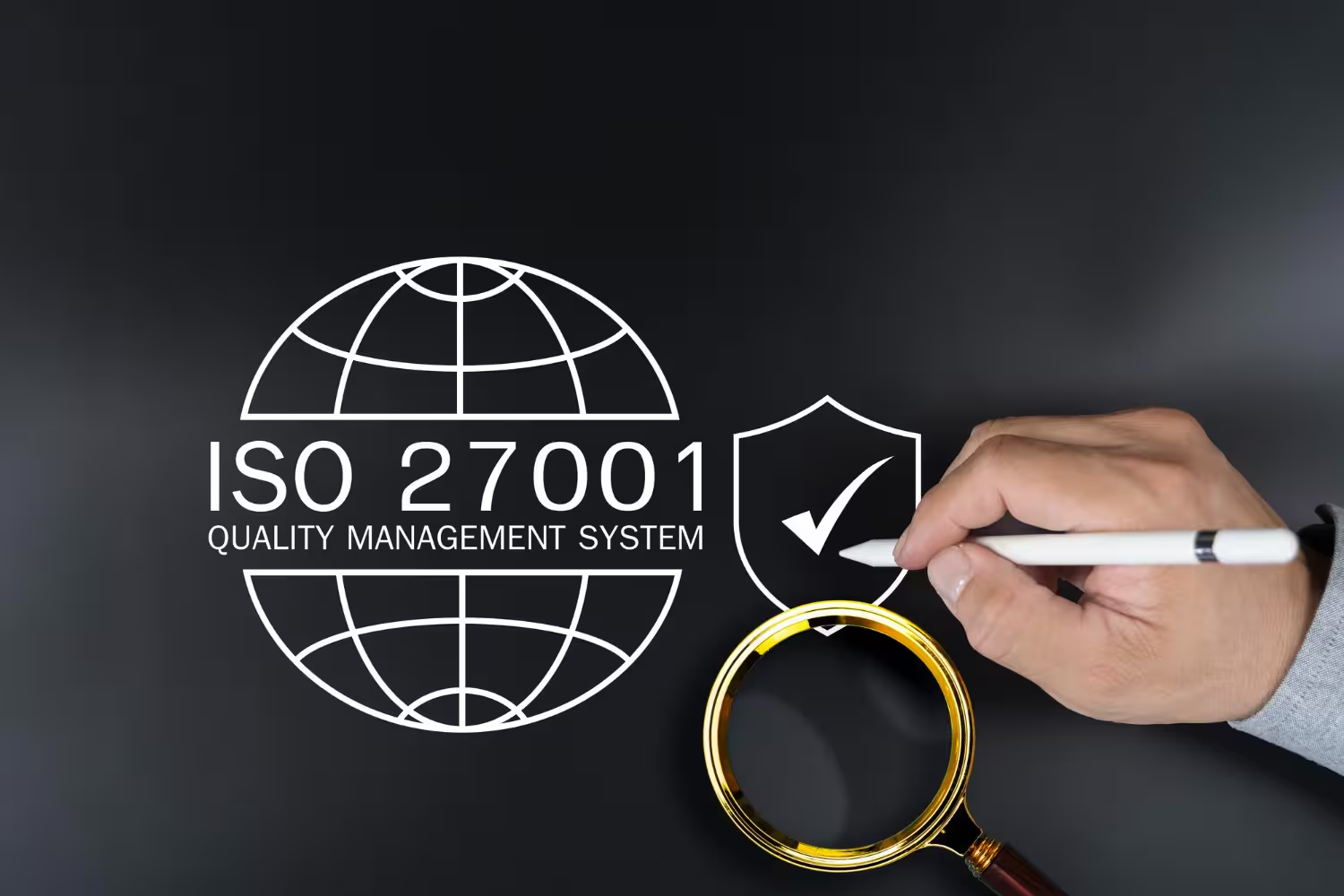45+ Most Alarming Florida Human Trafficking Statistics
Florida is the third-highest state for human trafficking cases, and it ranks second for labor trafficking cases. These figures are concerning, but that’s stating the obvious. The good news is that cases do get reported. This means that people are recognizing instances when they occur.
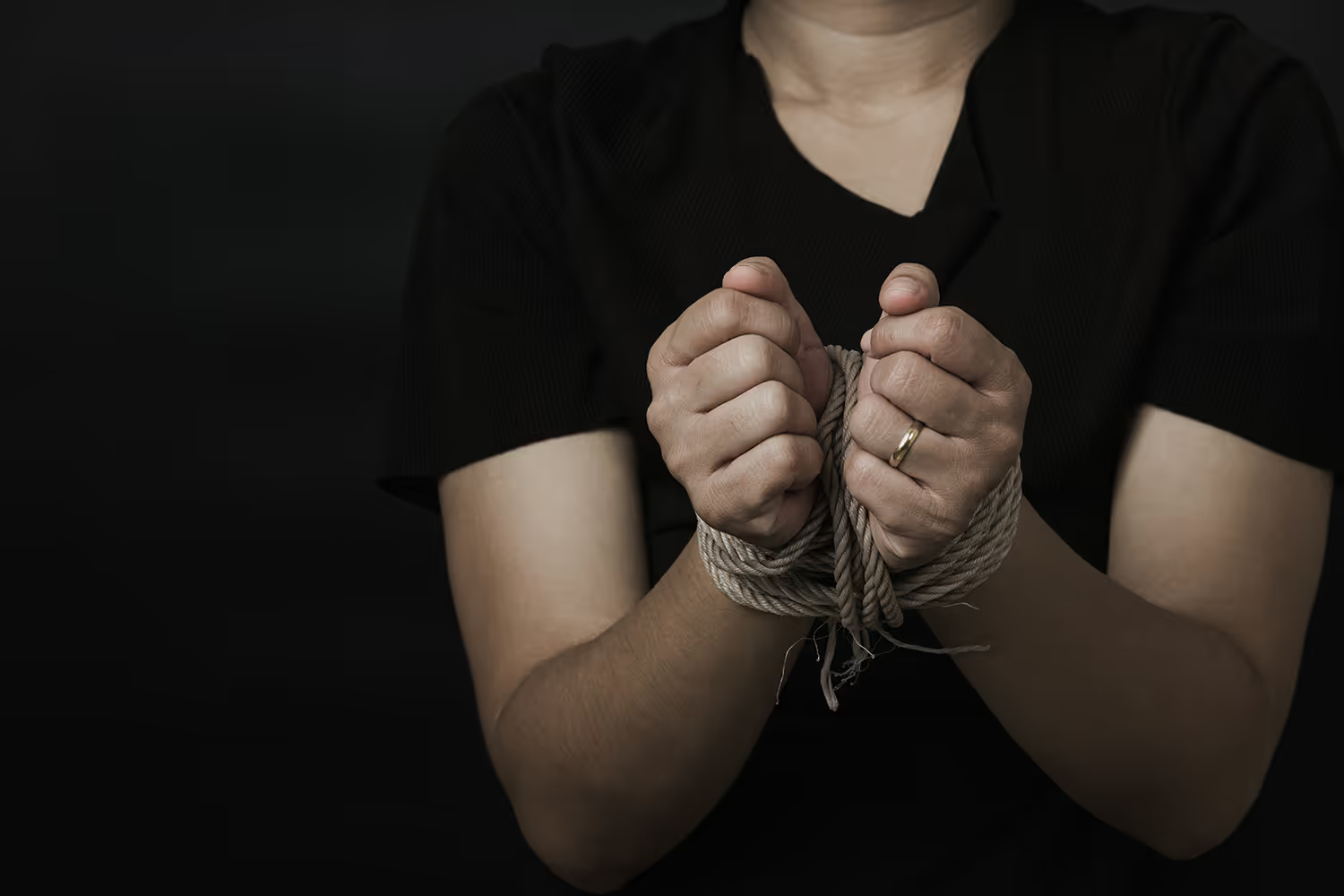
Human trafficking is a major problem in the United States, but for some states, it’s worse. For instance, Texas is the second-highest state for the number of cases reported. And following Texas is Florida.
According to Florida Alliance to End Human Trafficking, it’s the third-highest state for human trafficking cases. And it ranks second for labor trafficking cases.
But what’s the difference between human and labor trafficking? To understand key details about this issue in Florida, we first need to know how the state defines these different forms of criminal activity. Thankfully, Florida’s Department of Children and Families helps with this.
According to the department, sex trafficking is a commercial sex act that involves force, fraud, or coercion. It also includes scenarios where someone influences a minor to perform such acts. Examples of commercial sex acts include prostitution and/or pornography for the trafficker to profit.
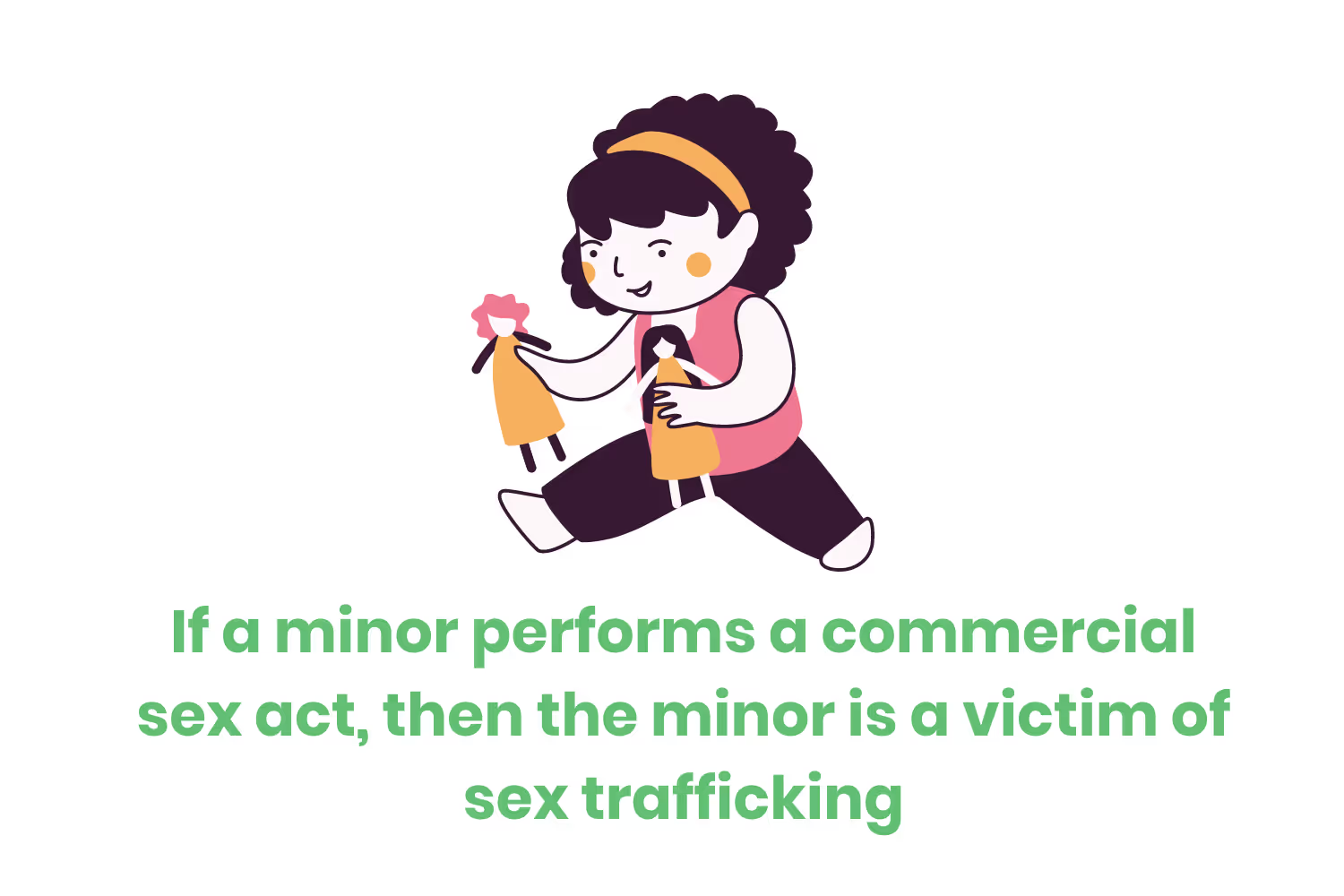
The department defines labor trafficking as the recruitment, harboring, transportation, provision, or obtaining of a person for labor or services. Again, this may also be through force, fraud, or coercion. It’s often to subject the victim to involuntary servitude, peonage (someone gets held against their will to pay off a debt), debt bondage, or slavery.
These include situations where an employer exploits their workers who are vulnerable due to any of the following reasons…
- High rates of unemployment
- Poverty
- Crime
- Discrimination
- Corruption
- Political conflict
- Citizenship status
- Cultural acceptance of the practice
Domestic servitude victims typically have an informal place of work, such as in the home. Since authorities can’t inspect these informal and private workplaces as easily as formal workplaces, these instances are more likely to go under the radar.
Now that you know how the state defines these key terms, how bad are these issues? Like I already mentioned, it ranks third for reported human trafficking cases and second for reported labor trafficking cases.
These figures are concerning, but that’s stating the obvious. The good news is that cases do get reported. This means that people are recognizing instances when they occur. When they report the situations, it makes it easier for authorities to handle them and develop laws that address the problem.
Let’s take a look at Florida human trafficking statistics and some of the efforts to resolve the issue.
General Statistics
- Florida is one of the three worst states for rates and reported cases of trafficked victims. There are 4.08 cases per 100k people. (World Population Review)
- Traffickers don’t discriminate against who they target. (National Human Trafficking Hotline) Victims include…
- Children
- Adults
- Females
- Males
- Ethnic minorities
- Other demographics

- Human trafficking is now the second most common criminal activity behind the illegal drug trade. (Stop Human Trafficking)
- There are around 20.9 million people enslaved throughout the world. (Stop Human Trafficking)
- Since the enactment of the Thirteenth Amendment in 1865, ALL slavery is illegal in the US, including human trafficking. (Stop Human Trafficking)
- Half of all trafficking victims in the state are minors. (Florida Health)
- In 2019, 734 human trafficking cases involved females, 125 cases involved males, and 3 cases involved gender minorities. (National Human Trafficking Hotline)
- 564 cases involved adults and 172 cases involved minors.
- 133 cases were foreign nationals and 82 were US citizens or lawful permanent residents.
- The average age that a trafficked victim is first used for commercial sex is 12 to 14 years old. (WFLA)
- Other victims are as young as nine years old.
Cases and Arrests
Since any type of slavery is a crime in the US, traffickers face prosecution when caught. In some cases, victims make reports themselves. And other times, people notice that someone else is a victim and make a report on that person’s behalf.
When others send these tips to authorities, law enforcement can find traffickers and arrest them at higher rates. This eventually leads to victims getting freed from their traffickers. Over the past several years, reports have led to several federal court cases.

- According to the National Human Trafficking Hotline, since 2007, there have been…
- 14,906 total contacts
- 4,636 total cases
- 5,844 moderate total victims
- 6,568 high total victims
Contacts include phone calls, texts, online chats, emails, and webforms received by the National Human Trafficking Hotline that referenced Florida. “Moderate” cases contain human trafficking indicators or resemble common trafficking scenarios, but lack core details of force, fraud, or coercion. And “high” cases contain a high level of trafficking indicators.
- The total cases in 2007 led law enforcement to more than 12,400 victims across the state. (WFLA)
- The National Human Trafficking Hotline also reported that in 2019 alone, there were…
- 2,068 contacts
- 896 reported human trafficking cases
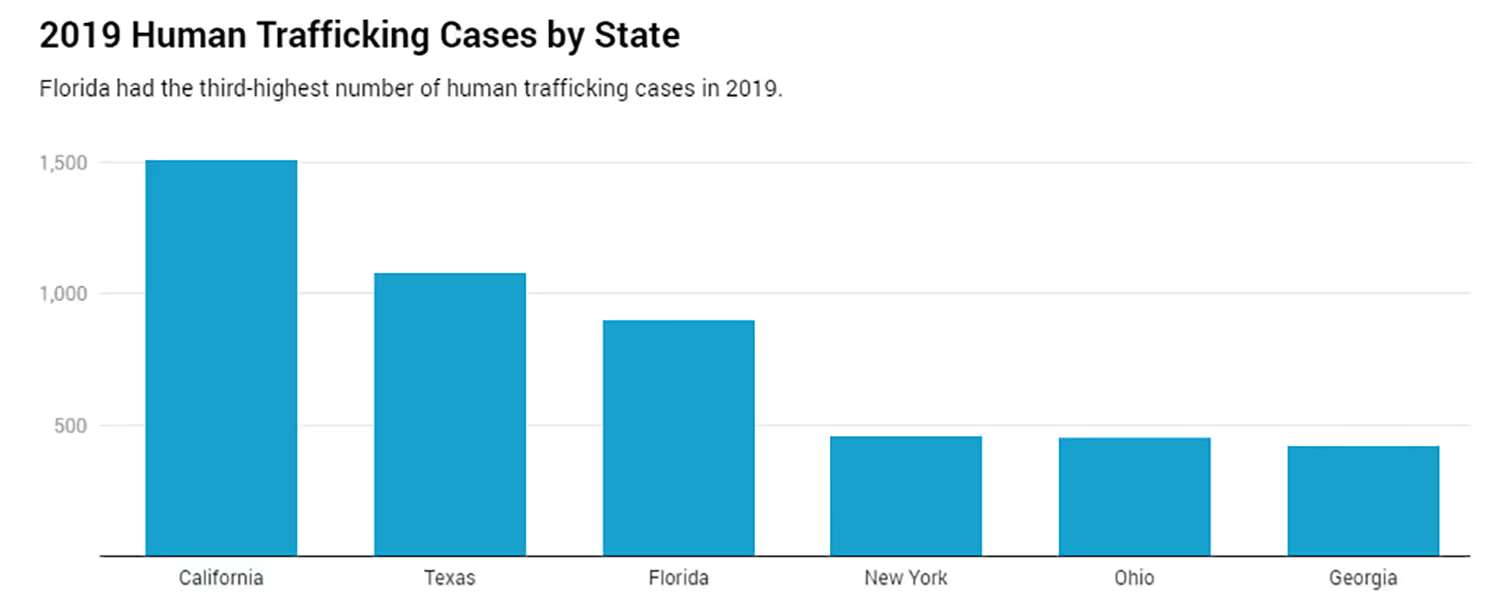
- These total trafficking reports included…
- 640 sex trafficking cases
- 128 labor trafficking cases
- 82 unspecified trafficking cases
- 46 sex and labor trafficking cases
- The cases in 2019 led to the identification of more than 600 trafficking businesses. (WFLA)
- 12 new criminal human trafficking cases got filed in federal courts in 2020. (Human Trafficking Institute)
- Seven defendants received positive convictions.
- 95% of active defendants got charged with sex trafficking.
- 5% got charged with forced labor.
- Four out of six convicted defendants had to pay restitution to their victim(s).
Trafficking Venues/Industries in Florida
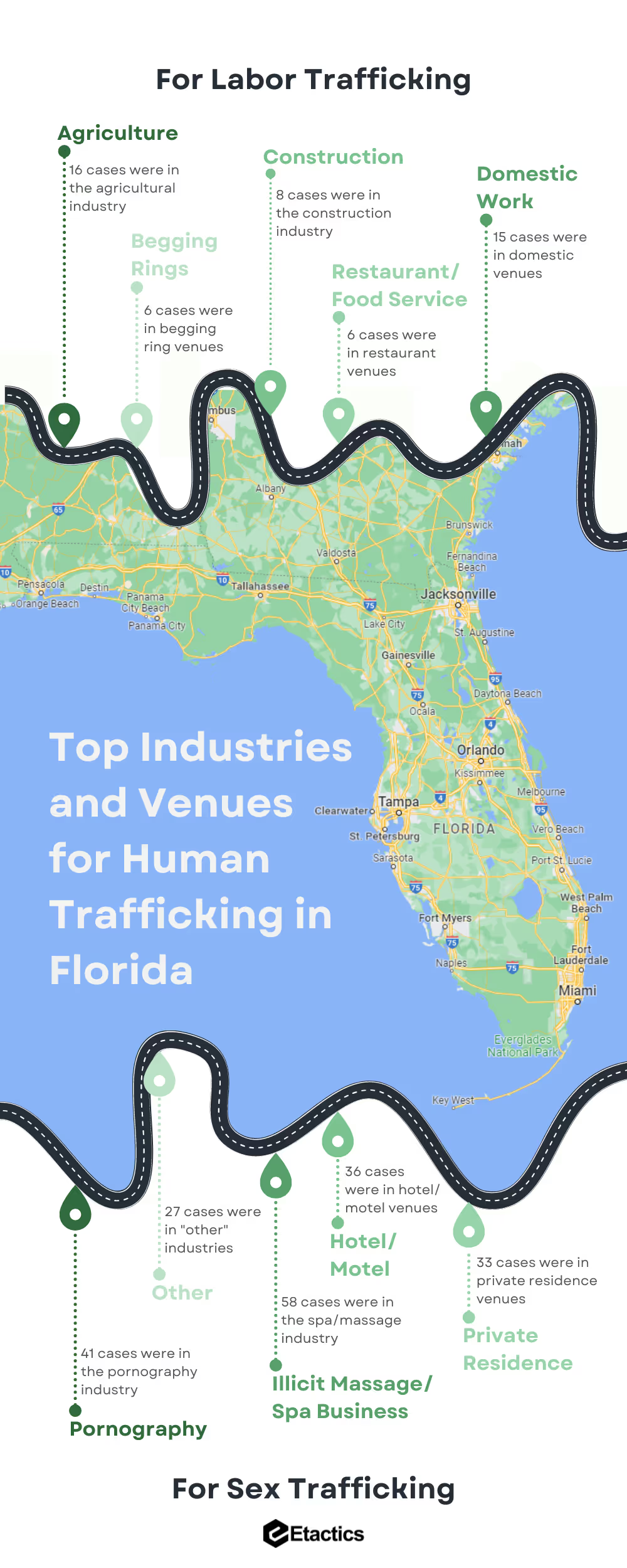
Top Venues/Industries For Labor Trafficking
Of the 128 cases related to labor trafficking cases reported in 2019, there were five popular tactics to hide victims in different industries. (National Human Trafficking Hotline)
The breakdown included...
- 19 Domestics Work cases
- 15 Agriculture cases
- 11 Traveling Sales Crew cases
- 11 Construction cases
- 8 Restaurants/Food Service cases

Top Venues/Industries For Sex Trafficking
Of the 640 reported sex trafficking cases in 2019, traffickers also hid victims in various venues and industries. (Human Trafficking Hotline)
This breakdown included...
- 146 Illicit Massage/Spa Business cases
- 55 Residence-Based Commercial Sex cases
- 41 Hotel/Motel-Based cases
- 35 Pornography cases
- 35 Online Ad, Venue Unknown cases

Laws and Regulations
Because Florida is the third-highest for human trafficking reports, it’s taking action to help solve the issue. Some laws are preventative, such as requiring training for lodging companies. Others have included the development of programs for identifying victims and helping them once they’re free from traffickers. Florida also clearly defines the consequences of the criminal activity.
Mandatory Training
In 2019, Florida’s Governor Ron DeSantis signed into law human trafficking legislation that affects lodging operations.
Section 509.096 in the state’s law includes mandatory human trafficking awareness training for lodging companies. These companies must train all employees who perform housekeeping duties, work at the front desk, or work in the reception areas.
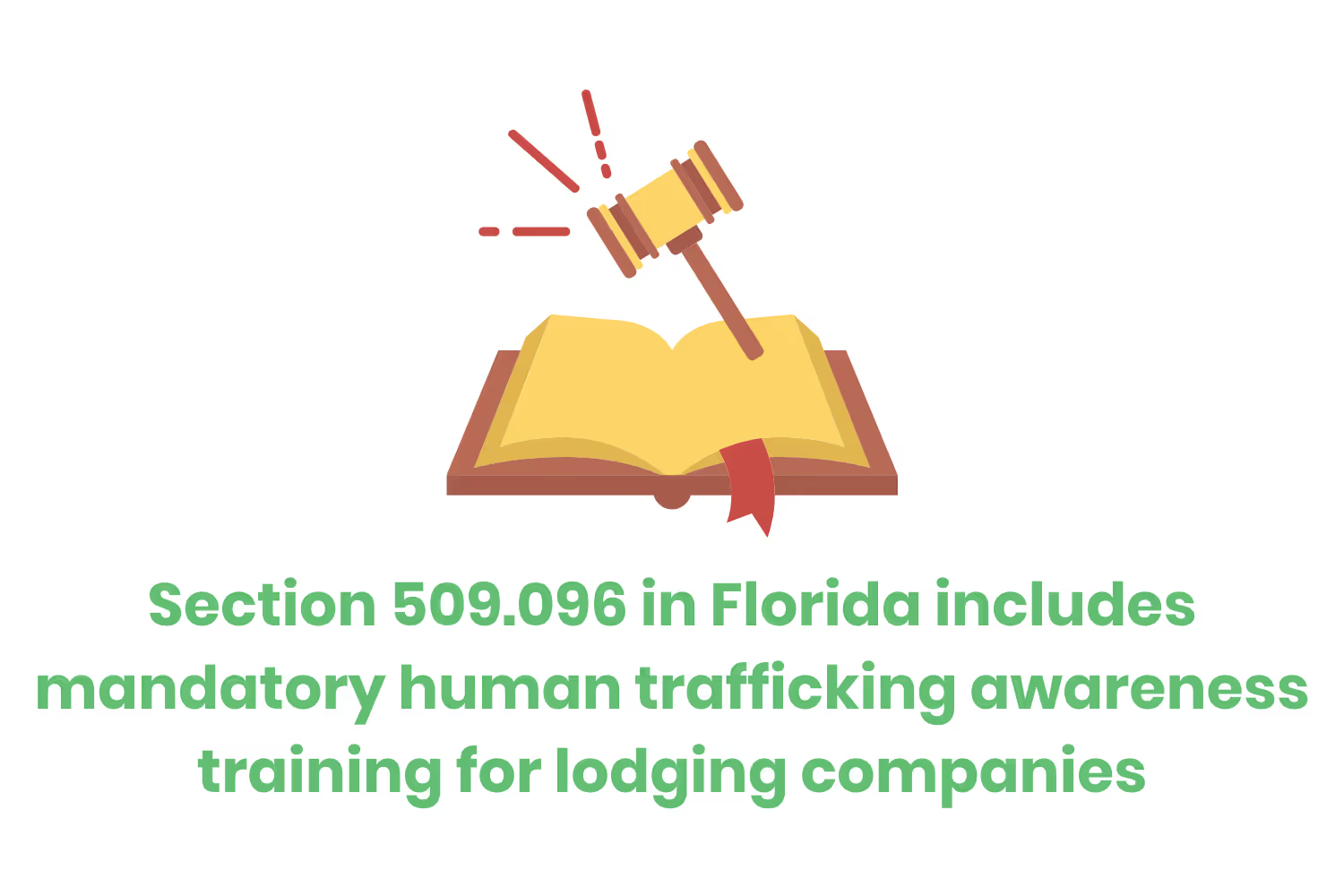
A lodging company that goes above and beyond would also train other positions that interact with guests such as the concierge, bell staff, and valet.
Council to Combat Trafficking
The Attorney General’s office has a 15-member Council chaired by Attorney General Moody which went into effect in 2014. Members of the council include law enforcement officers, prosecutors, legislators, and experts in the health industry, education industry, and social services industry.

The council builds on state and local partnerships to work on Florida’s dilemma. Its mission is to support victims by enhancing available care options.
The council’s duties include...
- Making recommendations for programs and services including making certifications for safe houses and safe foster homes.
- Making recommendations for capturing and prosecuting traffickers and improving the coordination between the different groups that respond to cases
- Holding an annual statewide summit discussing policies with institutions of higher education.
- Working with the Department of Children and Families to create and maintain human trafficking programs and services in Florida.
- Developing overall policy recommendations.
Punishments
Luckily, traffickers do get arrested and prosecuted by the courts. Florida’s laws outline the punishments that result from this illegal behavior.
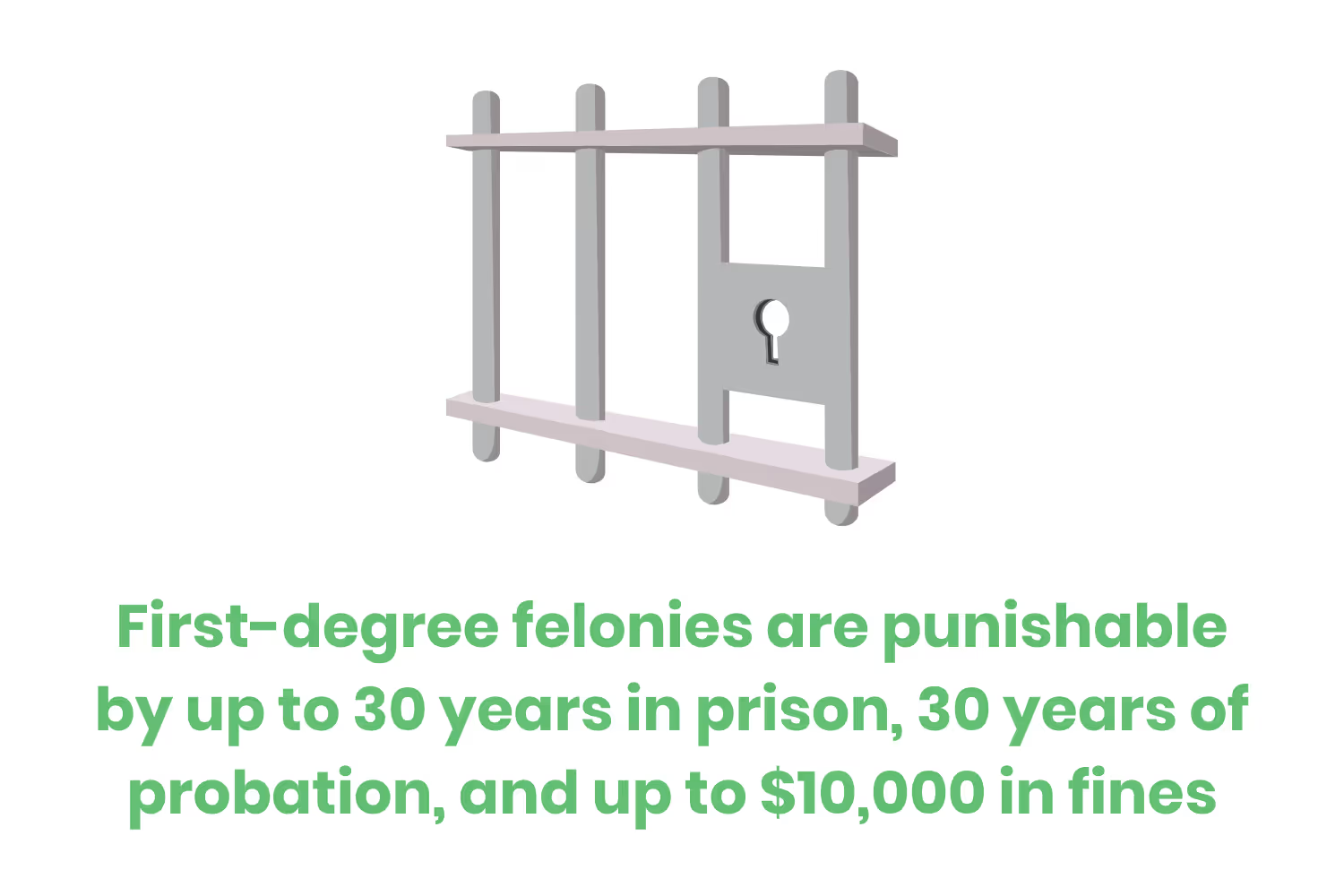
- In Florida, human trafficking for labor or commercial sex services is a first-degree felony with a Level 7, 8, or 9 offense severity level. (Law Office of Armando J. Hernandez)
- These convictions are punishable by imprisonment for up to 30 years and a maximum fine of $10,000.
- Human trafficking of a child or disabled person for commercial sex services is a life felony with a Level 10 offense severity level. (Law Office of Armando J. Hernandez)
- Punishment includes life imprisonment and a maximum fine of $10,000.
- Forcing another person to work, selling people, or sex trafficking children results in the punishment of life in federal prison. (Law Office of Armando J. Hernandez)
- Kidnapping someone for slavery or holding a person or selling them in involuntary servitude has a maximum federal prison term of 20 years. (Law Office of Armando J. Hernandez)
- Using coercion for labor or services or commercial sex activity is a first-degree felony. (Florida Courts)
- First-degree felonies include punishment of up to 30 years in prison, 30 years of probation, and $10,000 in fines. (Hornsby Law Firm)
- All Florida human trafficking offenses may face prosecution as RICO offenses as organized crime. (Florida Courts)
- RICO is the federal Racketeering Influenced and Corrupt Organizations law (Justia)
Conclusion
Due to its high rates and the number of reported cases in Florida, it’s one of the top three worst states for human trafficking. The situation can impact anyone. People as young as nine years old become victims, and traffickers don’t discriminate against who they target.
Because of these alarming Florida human trafficking statistics, the state is making efforts to improve the situation. It continues to pass new laws that address the problem, such as through training programs and professional councils.
People must recognize human trafficking instances and make the reports. This is why the state focuses so much on both employee training and programs that will help victims. That way, it makes it easier for law enforcement to catch and convict more traffickers so that rates will eventually decrease.
Emphasize your product's unique features or benefits to differentiate it from competitors
In nec dictum adipiscing pharetra enim etiam scelerisque dolor purus ipsum egestas cursus vulputate arcu egestas ut eu sed mollis consectetur mattis pharetra curabitur et maecenas in mattis fames consectetur ipsum quis risus mauris aliquam ornare nisl purus at ipsum nulla accumsan consectetur vestibulum suspendisse aliquam condimentum scelerisque lacinia pellentesque vestibulum condimentum turpis ligula pharetra dictum sapien facilisis sapien at sagittis et cursus congue.
- Pharetra curabitur et maecenas in mattis fames consectetur ipsum quis risus.
- Justo urna nisi auctor consequat consectetur dolor lectus blandit.
- Eget egestas volutpat lacinia vestibulum vitae mattis hendrerit.
- Ornare elit odio tellus orci bibendum dictum id sem congue enim amet diam.
Incorporate statistics or specific numbers to highlight the effectiveness or popularity of your offering
Convallis pellentesque ullamcorper sapien sed tristique fermentum proin amet quam tincidunt feugiat vitae neque quisque odio ut pellentesque ac mauris eget lectus. Pretium arcu turpis lacus sapien sit at eu sapien duis magna nunc nibh nam non ut nibh ultrices ultrices elementum egestas enim nisl sed cursus pellentesque sit dignissim enim euismod sit et convallis sed pelis viverra quam at nisl sit pharetra enim nisl nec vestibulum posuere in volutpat sed blandit neque risus.

Use time-sensitive language to encourage immediate action, such as "Limited Time Offer
Feugiat vitae neque quisque odio ut pellentesque ac mauris eget lectus. Pretium arcu turpis lacus sapien sit at eu sapien duis magna nunc nibh nam non ut nibh ultrices ultrices elementum egestas enim nisl sed cursus pellentesque sit dignissim enim euismod sit et convallis sed pelis viverra quam at nisl sit pharetra enim nisl nec vestibulum posuere in volutpat sed blandit neque risus.
- Pharetra curabitur et maecenas in mattis fames consectetur ipsum quis risus.
- Justo urna nisi auctor consequat consectetur dolor lectus blandit.
- Eget egestas volutpat lacinia vestibulum vitae mattis hendrerit.
- Ornare elit odio tellus orci bibendum dictum id sem congue enim amet diam.
Address customer pain points directly by showing how your product solves their problems
Feugiat vitae neque quisque odio ut pellentesque ac mauris eget lectus. Pretium arcu turpis lacus sapien sit at eu sapien duis magna nunc nibh nam non ut nibh ultrices ultrices elementum egestas enim nisl sed cursus pellentesque sit dignissim enim euismod sit et convallis sed pelis viverra quam at nisl sit pharetra enim nisl nec vestibulum posuere in volutpat sed blandit neque risus.
Vel etiam vel amet aenean eget in habitasse nunc duis tellus sem turpis risus aliquam ac volutpat tellus eu faucibus ullamcorper.
Tailor titles to your ideal customer segment using phrases like "Designed for Busy Professionals
Sed pretium id nibh id sit felis vitae volutpat volutpat adipiscing at sodales neque lectus mi phasellus commodo at elit suspendisse ornare faucibus lectus purus viverra in nec aliquet commodo et sed sed nisi tempor mi pellentesque arcu viverra pretium duis enim vulputate dignissim etiam ultrices vitae neque urna proin nibh diam turpis augue lacus.


